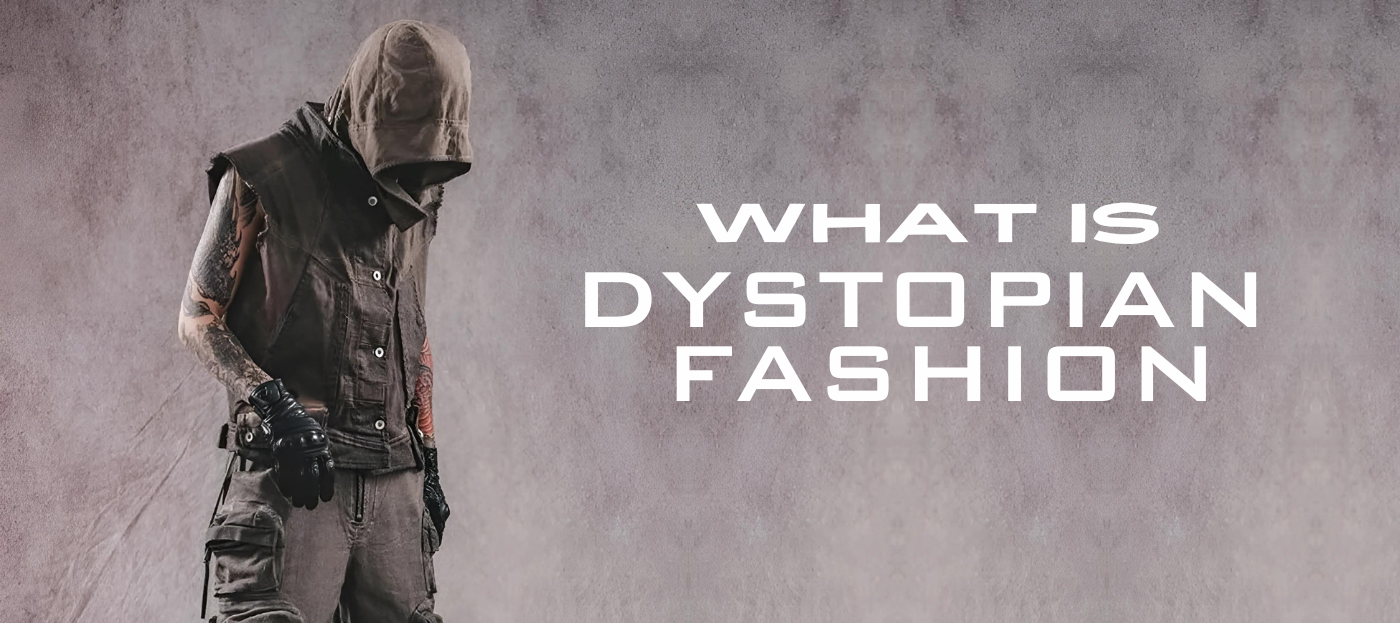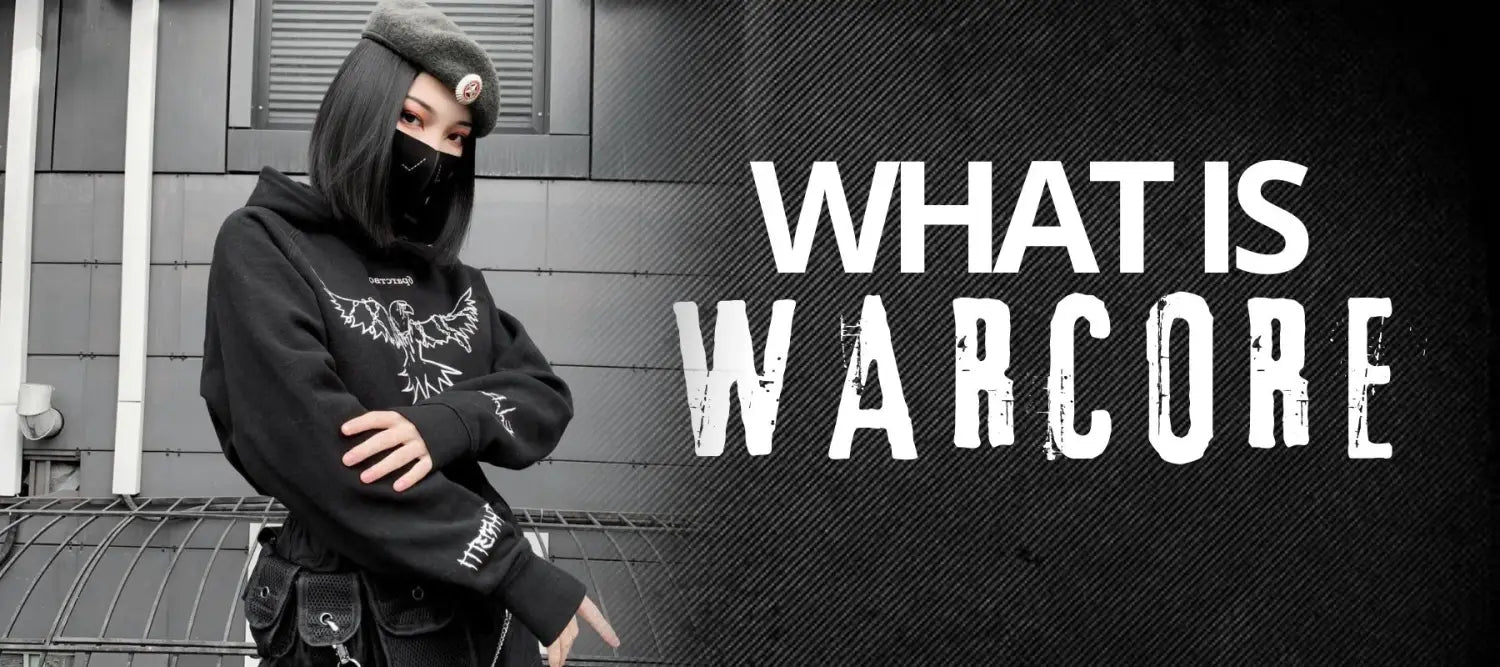What is Dystopian fashion
Dystopian fashion is a style inspired by the aesthetic of dystopian worlds often depicted in science fiction, post-apocalyptic narratives, and speculative futures. It reflects themes of survival, societal collapse, and resistance against oppressive regimes. This fashion trend combines utilitarian functionality with edgy, unconventional designs to create a look that is both rugged and futuristic.
Dystopian fashion shares many similarities with lunarcore, particularly in its futuristic aesthetic, utilitarian silhouettes, and clothing inspired by exploration of unknown and hostile worlds.

The Evolution of Dystopian Fashion
Dystopian aesthetic has journeyed through history as a mirror to society's anxieties, fears, and aspirations. Rooted in early 20th-century literature like Aldous Huxley's Brave New World and George Orwell's 1984, the aesthetic began as a conceptual reflection of themes such as authoritarian control and the loss of individuality. These themes laid the groundwork for a style that would visually represent societal concerns.
The foundation was further solidified by early films like Fritz Lang's Metropolis (1927), which showcased a stark divide between classes through sharp contrasts and mechanical elements in costume design. This visual style influenced the emergence of various subcultures from the 1960s to the 1980s. The punk movement of the 1970s, with its ripped clothing, safety pins, and leather jackets, embodied rebellion against oppressive systems, echoing dystopian themes of resistance.
The 1980s introduced cyberpunk influences through literature and films like William Gibson's Neuromancer and Ridley Scott's Blade Runner. These works blended advanced technology with societal decay, influencing fashion with dark color palettes, metallic fabrics, and a gritty urban style. Post-apocalyptic styles from movies like Mad Max emphasized practicality and survival gear, inspiring designers to incorporate distressed materials and utilitarian elements.

In the 1990s, the grunge movement brought an unkempt, layered look that reflected disillusionment with mainstream culture, aligning with dystopian themes of societal disengagement. Minimalist aesthetics emerged as designers like Helmut Lang experimented with monochromatic schemes and unconventional silhouettes, contributing to a futuristic yet austere look.
The turn of the millennium saw dystopian fashion entering mainstream consciousness, significantly influenced by The Matrix (1999). The film's sleek, all-black costumes bridged the gap between underground fashion and mainstream appeal. Japanese street fashion and the rise of techwear emphasized functionality and technology integration, embodying a futuristic and survivalist ethos.
The 2010s witnessed dystopian elements on high-fashion runways. Designers such as Rick Owens and Demna Gvasalia incorporated exaggerated proportions and unconventional materials, while apocalyptic media like The Hunger Games influenced trends toward utilitarian and rugged styles. Growing environmental concerns led to sustainable fashion practices like upcycling, aligning with dystopian themes of resource scarcity and adaptability.
Key features of Dystopian Fashion
Dystopian fashion is distinguished by its fusion of functionality, edgy aesthetics, and influences from post-apocalyptic and speculative narratives. The key features that define this style include:
Dark and Muted Color Palettes: Dominant use of blacks, grays, and earth tones like olive and brown to evoke a somber and gritty atmosphere.
Distressed and Durable Materials: Incorporation of worn, torn, or weathered fabrics such as leather, denim, and heavy-duty textiles that suggest resilience and survival.
Layered and Asymmetrical Silhouettes: Clothing often features multiple layers, uneven hems, and unconventional cuts, providing both practicality and a rebellious edge.
Functional and Utilitarian Design: Emphasis on practicality with elements like multiple pockets, straps, buckles, and tactical details suitable for a survivalist setting.
Techwear and Advanced Fabrics: Integration of technical materials that offer functionality such as weather resistance, breathability, and adaptability, aligning with the survivalist aspect of dystopian settings.

Why is Dystopian fashion trending
Dystopian fashion has gained significant popularity in recent years, becoming a prominent trend in both streetwear and high fashion. The surge in dystopian narratives in films, television series, video games, and literature has significantly impacted fashion trends.
Influence of Pop Culture
Popular franchises like Mad Max: Fury Road, and Blade Runner 2049 showcase striking visual aesthetics that blend futuristic elements with rugged, utilitarian designs. These visuals inspire designers and consumers alike, translating cinematic styles into wearable fashion.
Social Media and Digital Communities
Platforms like Instagram, TikTok, and Pinterest facilitate the rapid spread of fashion trends and allow niche styles to gain mainstream attention. Influencers and fashion enthusiasts showcase dystopian outfits, inspiring others to adopt the aesthetic.

Technological Advancements and Techwear
The integration of technology into daily life has influenced fashion to become more functional and innovative. Techwear, a subset of dystopian fashion, focuses on garments that offer utility through advanced materials and features like weather resistance and adaptability. This fusion of fashion and technology caters to modern needs and appeals to a tech-savvy audience.
Dystopian outfits vs. Techwear

In the ever-evolving landscape of futuristic fashion, dystopian outfits and techwear emerge as two compelling styles that capture the essence of innovation and individuality. Dystopian fashion draws inspiration from post-apocalyptic narratives, featuring rugged, worn-in looks with distressed materials and muted earth tones. This aesthetic emphasizes survival and resistance, incorporating asymmetrical cuts, layered clothing, and utilitarian accessories like harnesses and tactical belts.
On the other hand, techwear focuses on the fusion of functionality and sleek design, utilizing advanced materials like Gore-Tex and nylon to provide weather resistance and breathability. Characterized by minimalist silhouettes and modular components, techwear offers practical solutions for urban living without sacrificing style.
While dystopian outfits and techwear share some common ground in their futuristic inspiration and functional focus, they cater to different aesthetics and purposes.
Dystopian outfits: Creating Your Dystopian Look
Dystopian fashion captures the essence of societies facing turmoil, blending functionality with avant-garde aesthetics to create a look that is both practical and expressive.
To assemble a cohesive dystopian outfit, focus on blending these elements seamlessly. Start with a base layer of functional pants, add a statement jacket with utilitarian features, and complete the look with robust footwear. Accessorize with items like tactical belts, harnesses, and minimalist jewelry to enhance the theme. Stick to muted tones such as blacks, grays, olives, and browns to maintain the somber mood. Experiment with layering to add depth, using pieces like vests, scarves, and arm warmers.
Below, we explore key elements of dystopian outfits, focusing on jackets, pants, and footwear that define this distinctive fashion trend:
Dystopian Jackets
Dystopian jackets are central to the aesthetic, offering both protection and a statement of style. Designed to withstand harsh environments, they reflect the wearer's resilience and individuality. These jackets often feature rugged materials like distressed leather, heavy-duty canvas, and waxed cotton, providing durability and a weathered look. Unconventional cuts and asymmetrical designs break away from traditional forms, showcasing uneven hems, oversized hoods, and dramatic collars. Functional elements such as multiple pockets, straps, buckles, and reinforced stitching enhance practicality, while layering adds depth and complexity to the outfit. Pairing a distressed leather jacket with a hooded cloak or choosing a jacket with tactical elements like detachable components can elevate the dystopian vibe.
Dystopian Pants
Pants in dystopian fashion prioritize mobility and functionality, designed to support an active lifestyle in unpredictable conditions. They balance comfort with a rugged aesthetic, often featuring technical details. Durable fabrics like reinforced denim, heavy cotton twill, and technical synthetics ensure longevity. Cargo and utility styles with multiple pockets and storage options reflect the need to carry essentials. Adjustable features such as drawstrings, adjustable cuffs, and waistbands provide a customizable fit, while distressed and textured finishes add character and a sense of history. Opting for cargo pants with asymmetrical pocket placement or layering leggings under shorts can contribute to an unconventional look.
Dystopian Footwear
Footwear anchors the dystopian outfit, combining robustness with stylistic edge. Shoes and boots are designed to endure, offering protection and support while complementing the overall aesthetic. Sturdy construction using materials like thick leather, rubber soles, and metal hardware ensures durability. Military and combat styles are prevalent, featuring lace-up fronts, buckles, and reinforced toes. Functional details such as zipper closures, adjustable straps, and padded ankles enhance comfort and utility, while a weathered appearance contributes to a lived-in, authentic look. Choosing combat boots with added hardware like chains or incorporating high-top sneakers with rugged soles can complete the ensemble.
Dystopian fashion brands
Dystopian fashion has gained prominence for its fusion of futuristic elements with rugged, utilitarian designs that evoke themes of survival, resistance, and adaptability. Several fashion brands specialize in or incorporate dystopian aesthetics into their collections.
SHADXW
SHADXW is a techwear brand that contributes to the dystopian fashion landscape. Inspired by streetwear and cyberpunk aesthetics, SHADXW offers pieces that embody the essence of dystopian style. Their designs often feature dark color palettes, innovative materials, and utilitarian details such as multiple pockets, straps, and zippers.
Rick Owens
Rick Owens, an American designer known for his dark, avant-garde aesthetic, features draped silhouettes, asymmetrical cuts, and a monochromatic palette. His use of distressed fabrics and oversized layering creates a non-conformist look.
Demobaza
Demobaza, a Bulgarian brand founded by Demo and Tono, combines futuristic concepts with a raw, post-apocalyptic look. Known for deconstructed garments, heavy layering, and utilitarian details like zippers and straps, they create pieces that embody a blend of futurism and ruggedness. Acronym, a German brand specializing in high-tech, functional apparel, merges techwear with dystopian aesthetics through minimalist yet tactical designs using advanced materials and utilitarian features.
Julius
Julius, a Japanese brand by Tatsuro Horikawa, focuses on industrial and gothic styles, emphasizing monochromatic palettes and designs that blend gothic and industrial influences. Gareth Pugh, a British designer recognized for conceptual and avant-garde creations, utilizes exaggerated silhouettes, unconventional materials, and dramatic, futuristic aesthetics to convey a dystopian vision.
Y-3
Y-3, a collaboration between Adidas and Japanese designer Yohji Yamamoto, merges sportswear with high fashion, featuring sleek designs, dark color schemes, and functional details suitable for a dystopian wardrobe. The brand 11 by Boris Bidjan Saberi, a diffusion line of designer Boris Bidjan Saberi, offers asymmetrical designs, layering, and technical fabrics that align with dystopian fashion themes.
Undercover
Undercover, a Japanese brand by Jun Takahashi blending streetwear with high fashion, incorporates graphic prints, layering, and mixed materials contributing to a dystopian aesthetic.
Stone Island
Stone Island, an Italian brand famous for innovative fabric treatments, features utilitarian designs and technical garments that can be integrated into dystopian outfits.
Outlier
Outlier, a New York-based brand specializing in technical apparel, focuses on functionality and advanced fabrics, offering pieces that fit dystopian themes.
KTZ
KTZ (Kokon to Zai), a London-based brand known for bold prints and avant-garde designs, mixes cultural references with futuristic elements to create a unique dystopian look. Void Main, a smaller brand focusing on minimalist designs with a futuristic touch, offers garments with clean lines, muted colors, and functional details.
SPYDER
SPYDER, a Korean label blending streetwear with futuristic designs (not to be confused with the sports brand), is known for techwear-inspired pieces, including jackets and pants with multiple pockets and technical fabrics.




